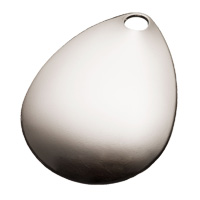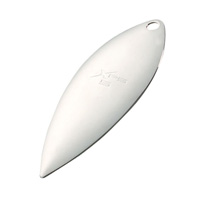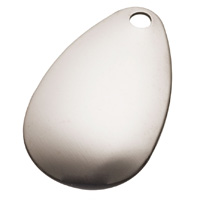
Spinnerbaits have had a place on fishing tackle store shelves for a long time. Their effectiveness and efficiency is what make them a top choice for bass anglers all over North America. But where do you start when it comes to choosing the right spinnerbait and how to work it? Let these tips lead the way.
![]() Spinnerbaits are characterized by their blades, which act like "propellers" in the water.
Spinnerbaits are characterized by their blades, which act like "propellers" in the water.
Spinnerbait Blade Types
|
Colorado Blade About: Colorado blades exhibit a round design which make them a top choice for producing vibrations in the water. When to use: They can call fish in from great distances and work well in stained or muddy water. Colorado-bladed spinnerbaits run the deepest out of all three designs and lend themselves well to slow-rolling in deep water. |
 |
|
Willow Leaf Blade About: Willow Leaf blades lead the pack when it comes to giving off flash. They are highly visible for great distances and work well in clear water for roaming fish. When to use: Although they give off the least amount of vibrations of the three, they do reign supreme for covering water quickly and efficiently, especially the shallow stuff. |
 |
|
Indiana Blade About: Indiana blades are a cross between the Colorado and Willow Leaf design, showcasing a slightly more streamline and curved blade in comparison to the prior. Able to throw off a great deal of vibration, it ranks second in sound production between the three. When to use: It is a great option for working medium depth areas of the lake, especially when you want an in-between lure for covering a variety of water conditions. |
 |
How to Fish With Spinnerbaits
| The Basic Toss | Deep Water Tactic | Inactive Bass & Shallow Water |
| This is the simplest tactic to master. Toss the bait out with a medium length cast, let it sink for a second, and then begin a steady retrieve to bring the bait back to the boat. The spinnerbait should travel just under the water's surface (between 1 and 4 feet deep) for maximum effectiveness, with the blades constantly turning throughout the entire retrieve. | The slow rolling presentation is a staple for coping with deep water. Cast your spinnerbait out, letting it fall on a slack line to the bottom. At this point, a slow yet steady retrieve just off bottom is all it takes. Make sure to keep the bait moving at all times for increased effectiveness, while bumping bottom structure occasionally. | Fluttering (or dead-dropping) a spinnerbait is an ideal tactic when faced with neutral or inactive bass or when the water you are fishing has visible structure areas in relatively shallow water. Fluttering your bait quite simply means stopping your retrieve and allowing the spinnerbait to "flutter" or spiral down on a slack line. This sudden change of direction can often entice following fish or bass waiting in ambush to strike. |
- 10103 views


